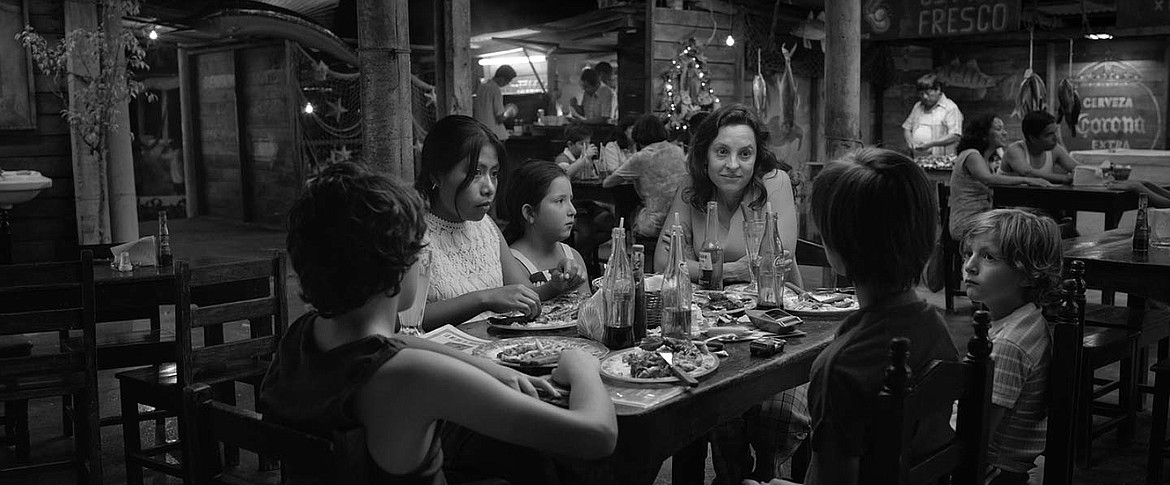Spectacle and intimate storytelling fuel 'Roma' and 'Into the Spider-Verse'
“Roma,” the Spanish-language film from Oscar-winning director Alfonso Cuarón, deserves to be seen on a giant screen. Available to stream now on Netflix, viewers should at least hold their phones close to their eyes and give the film their undivided attention.
Shot in vivid black-and-white, every individual composition in “Roma” is truly a work of art. The story, focusing on the life of a live-in housekeeper to a middle-class family in Mexico City circa 1970, seems small in scale compared to the director’s more popular efforts like “Gravity” or “Children of Men.” But Cuarón, who also wrote, produced, shot and edited the film, builds “Roma” into an epic by incorporating the rich culture of Mexico City during a time of escalating political unrest.
The film stars Yalitza Aparicio as Cleo, a maid and nanny serving a family that includes four children. Early in the film, the little-seen father of the family leaves, but his wife, Sofia (Marina de Tavira), tells the children he has gone on an extended work research trip. It leaves Cleo to take on more household responsibilities, but she also has her own unplanned pregnancy to navigate.
Aparicio, hired for the film with no formal training in acting, is magnetic as Cleo. She carries the film with a warmth and relatability that provides a necessary anchor as Cuarón incorporates broader story elements and themes. The movie’s ambition swells in the final 45 minutes or so, and the emotional wallop hinges entirely on understanding Cleo’s perspective.
The masterful detail of Cuarón’s vision in “Roma” can’t be understated. As it plays out an overarching narrative, certain sequences and even individual compositions tell their own complex stories. There are more striking and thought-provoking images in a five-minute stretch of “Roma” than most films can muster in an entire runtime. Consider just the film’s opening shot — an extended close up of water being sloshed around a garage floor by Cleo’s mop. The reflection of the sky can be seen in the water, and at one point an airplane can be seen flying overhead. It’s an image that returns to “Roma” at key moments.
It’s easy to turn on a movie on Netflix and only half-watch it. Don’t let anything take your eyes off “Roma.” It’s a mastercraft in visual storytelling.
Though seemingly on the opposite end of the cinematic spectrum, “Spider-Man: Into the Spider-Verse” also deserves to be seen on a giant screen, and luckily it’s readily available in that format locally. Masquerading as holiday children’s entertainment, “Spider-Verse” delivers a fresh and visually dazzling theatrical experience that rivals the thrill of seeing Sam Raimi’s “Spider-Man 2” for the first time.
Rather than focus on another story of Peter Parker, “Spider-Verse” hones in on an origin tale for young Miles Morales (voice of Shameik Moore), a New York City teenager who struggles adjusting to a new school, connecting with his police officer father (Brian Tyree Henry) and, oh yeah, with the superpower-enabling bite of a radioactive spider.
These origin story beats pass swiftly and economically in “Spider-Verse,” mostly because the film needs to make time for several other Spider-people via an interdimensional calamity. Most notably, Miles finds himself under the tutelage of a battle-worn, lazy and depressed Peter Parker from another dimension (a reliably funny Jake Johnson). Hailee Steinfeld voices a superhero version of Gwen Stacy, and Nicolas Cage and comedian John Mulaney voice two other hilarious alt-Spider standouts.
“Spider-Verse” contains numerous gags and fan-friendly Easter eggs, and while the spoof-centric fingerprints of Phil Lord and Christopher Miller (architects of “The Lego Movie” and its Batman-themed spinoff) can be felt throughout, the movie makes a sincere effort to give Miles his own epic and satisfying origin story, and the relationships with his parents, his uncle (Mahershala Ali) and sorta-mentor Peter provide an emotional center to what is a purposefully frantic and ambitious tale.
“Into the Spider-Verse” is visually spectacular, utilizing a style that incorporates comic book panels, cover iconography and numerous individual techniques for coloring and character design in order to pay homage to multiple eras of comic book history. Combine all that with bright colors, bold 3D and an editing style that mimics comic panel action choreography, and “Spider-Verse” looks like no other computer animated film.
Even with all its eye candy, the film still knows it needs to tell a compelling story. It features several iconic villains and touches on all the core Spidey-thematic beats (the great power-great responsibility thing being just one) without ever feeling overstuffed.
Superheroes had another huge year in 2018, with “Black Panther,” “Avengers: Infinity War,” “The Incredibles 2” and even “Venom” netting huge dollars at the box office. Even as a supporter of all those movies to some degree (yes, even stupid, stupid “Venom”), the clear winner of the bunch is “Spider-Man: Into the Spider-Verse.” It pushes the genre in an exciting and necessary new direction.
•••
Tyler Wilson can be reached at twilson@cdapress.com



